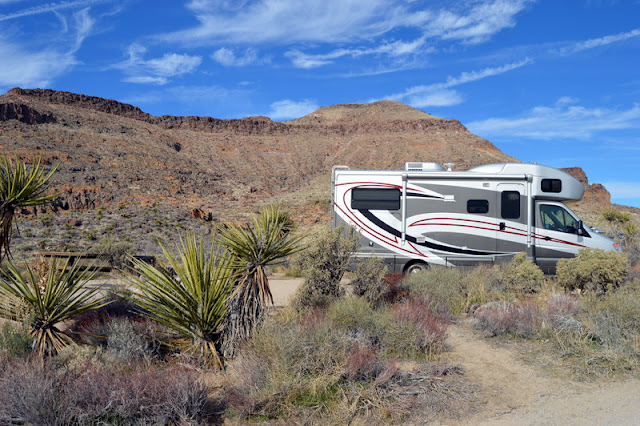We spent a couple of days in Barstow –
the last significant California town before Mojave Desert Preserve
and Death Valley National Park. Just north of town, we drove five
miles over a washboard dirt road to Rainbow Basin Natural Area. I
hiked a bit into the canyon, and it is a bit eerie walking in the
sandy wash being able to reach out and touch both sides of the rock
canyon walls. Not as colorful as others we have seen, but was a nice
little walk. There was a scenic road tour, but it was too sandy and
narrow for RVs and trucks.
We stayed the night at Calico Ghost
Town Campground, about 10 miles north of Barstow. It was difficult
finding a level site as it was on the side of a mountain, but was a
quiet place to spend the night with only a few other campers in the
whole campground.
 |
| Sunrise in Calico Ghost Town |
After a beautiful mountain sunrise, we headed to the Ghost Town –
abandoned in the late 1800's when silver prices dropped
precipitously. The town was “saved” by Walter Knott, of Knott's
Berry Farm fame in the early 1950's and donated to the county in the
1960s. The town had a high population of just under 2,000 and is a mixture of original buildings and replicas. We
spent a couple of hours visiting the shops and walking around the
area.
 |
| Calico Main Street (the only street) |
 |
| Maggie Silver Mine |
 |
| Bottle House |
 |
| Mountains with unusual faults in Calico Ghost Town |
Leaving there, we headed back east to
tour the Mojave Desert Preserve. This preserve is part of the great
Mojave Dessert that spans four states – Arizona, California, Nevada
and Utah. As we drove across the desert, we started climbing in
elevation, and when we got to about 1500', we began to see thousands
of Joshua trees. They call it a “forest” but it certainly is not
what we think of in the East when we think of forest. We drove
through huge black and reddish volcanic rock deposits and over a
pass, then down into Kelso depot. This had been a major railroad
staging point for WWII supplies with a beautiful Spanish mission
style building. The original eating counter is there and is the
visitor center for the Preserve. We watched a movie about the
seasons, wildlife, and plants in the desert.
 |
| Kelso Depot - the only viable building in town run by the Bureau of Land Management |
 |
| The original eating counter, now a gift shop |
The ranger told us we could easily make
it on a dirt road to the campground which was 20 miles away, instead
of going around on the paved road which made it 64 miles. Uh.
Terrible road – deeply rutted in places, sandy in others, and then
the horrendous washbooard when not rutted or sandy. Took us about the
same time as if we had taken the long route, but we did make it
without incident and got ourselves a campsite in the no hookup
campground. A few folks were here, but not many. At dusk, we
spotted a bobcat just outside our window, but too dark and he was
moving steadily, so I didn't get a photo.
 |
| Joshua Tree Forest |
 |
| Bare bones campsite in the mountains of Mojave Desert Preserve |
 |
| View from our campsite |
 |
| Kelso Sand Dunes in Mojave Desert Preserve |
 |
| Volcanic Cinder cones in Mojave Desert Preserve |
We ventured outside after dark to try
our night vision skills in this dark sky area, but it was just too
cold to sit waiting for our eyes to adjust. We got on our way to
finish the paved route south through the park, enjoying more Joshua
trees, rugged mountains and did sight a mule deer, but no endangered
desert tortoises, which are indigenous here, We drove west on I-40
to Baker, to fill up with fuel at $4.65/gallon! Yikes. Then headed
north towards Death Valley. Some beautiful scenery along the way.
 |
| World's largest thermometer in Baker, California |
We had planned on stopping in a small
town of Tecopa, but when we got there, paid for our site, we found
there is no fresh water in the town. They do have mineral springs and their mineral pools looked popular, but a bit dilapidated and a large, mostly dry lake bed of white salt. Got a refund and drove 10 miles
up the road to another small town called Shoshone and got a site with
electric, water and a dump. We needed full service before heading
into Death Valley where we could not get a serviced site until
Tuesday. They do have gas stations in these towns, but not grocery
stores and absolutely no cellphone service. This part of California is certainly not what we think of as Southern California - more like rural Nevada, Utah, Arizona. How do they live here???
Eating dinner, we were treated to an
earthquake – just a gentle shaking, as if someone were pushing on
the side of the RV, but very noticeable. Woke to yet another
glorious sunrise with clear skies.